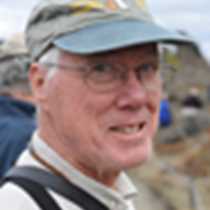Peninsula Valdez, Patagonia, Argentina
Patagonia: The flat, dry shrubland of southern Argentina. The Andes mountains far to the west have intercepted any moisture. The dry winds of Patagonia sweep freely across the landscape, uninterrupted by trees. It is a land of huge estancias where sheep graze, tended by gauchos on horseback. They share the land with guanacos, one of the South American camellids, and flightless lesser or Darwin's rheas. Charles Darwin spent months travelling through Patagonia in the company of gauchos, happy to be away from the mal de mer that plagued him on the Beagle. Patagonia is still much as Darwin described it in his remarkable journal, published as The Voyage of the Beagle.
The National Geographic Explorer docked at Puerto Madryn and we were away early to beat the mid-day winds. We passed over a narrow isthmus to reach Pyrámades, where we boarded local boats for an experience with the Southern Right Whales of Peninsula Valdez. The whales gather here each spring to bear their calves and engage in their breeding behavior in the shallow gulfs, Golfo Nuevo and Golfo San Jose, on either side of the Peninsula.
The most distinctive feature of the right whales (there is another species in the north) is the development of callosities – discrete patches of rough, callous skin that are colonized by whale lice – on and around their heads. Each whale has a prominent "bonnet" on the top of the head, another patch on the chin, and yet another above each eye. Beyond that, the pattern of patches is so distinct that individual whales can be recognized, and this attribute has aided enormously in the study of right whale behavior. The mother - calf pairs showed no concern for our presence, and we were able to get quite close for outstanding views and photographs.
Whales lose patches of their skin at a rate far faster than other mammals. Kelp gulls have, for generations, fed on the sloughed skin, but in recent years the gulls have taken to snatching skin while it is still attached, to the evident displeasure of the whale. They have become, in fact, aggressive parasites of the whales. Each individual whale or cow-calf pair was attended by one or more gulls that attacked as the whales came to the surface to breath. That was not pretty, but there is a happy thought to conclude our discussion of southern right whales. Right whales are slow-moving with a thick layer of blubber, so they were prime targets for whalers. (Wait! I did promise a happy thought.) Their population was seriously depleted by commercial whaling, but in recent years the southern right whales have made a remarkable recovery. Their population is now increasing at the very rapid rate of about 7% per year. (Unfortunately, the same cannot be said for the endangered northern right whales, but that is not part of the happy thought.)
Our day at Peninsula Valdez included a visit to Estancia San Lorenzo, where we were served an Argentine asado lunch featuring Patagonian lamb cooked over an open fire. Near the beach on the Estancia is a breeding colony of Magellanic penguins. These are of the group of burrowing or jackass penguins (together with the African, Humboldt or Peruvian, and Galapagos penguins.) All of them have patches of bare skin on the face, the better to dissipate heat in the relatively warm areas in which they breed. It was our first penguin species of this remarkable trip, but far from our last.



